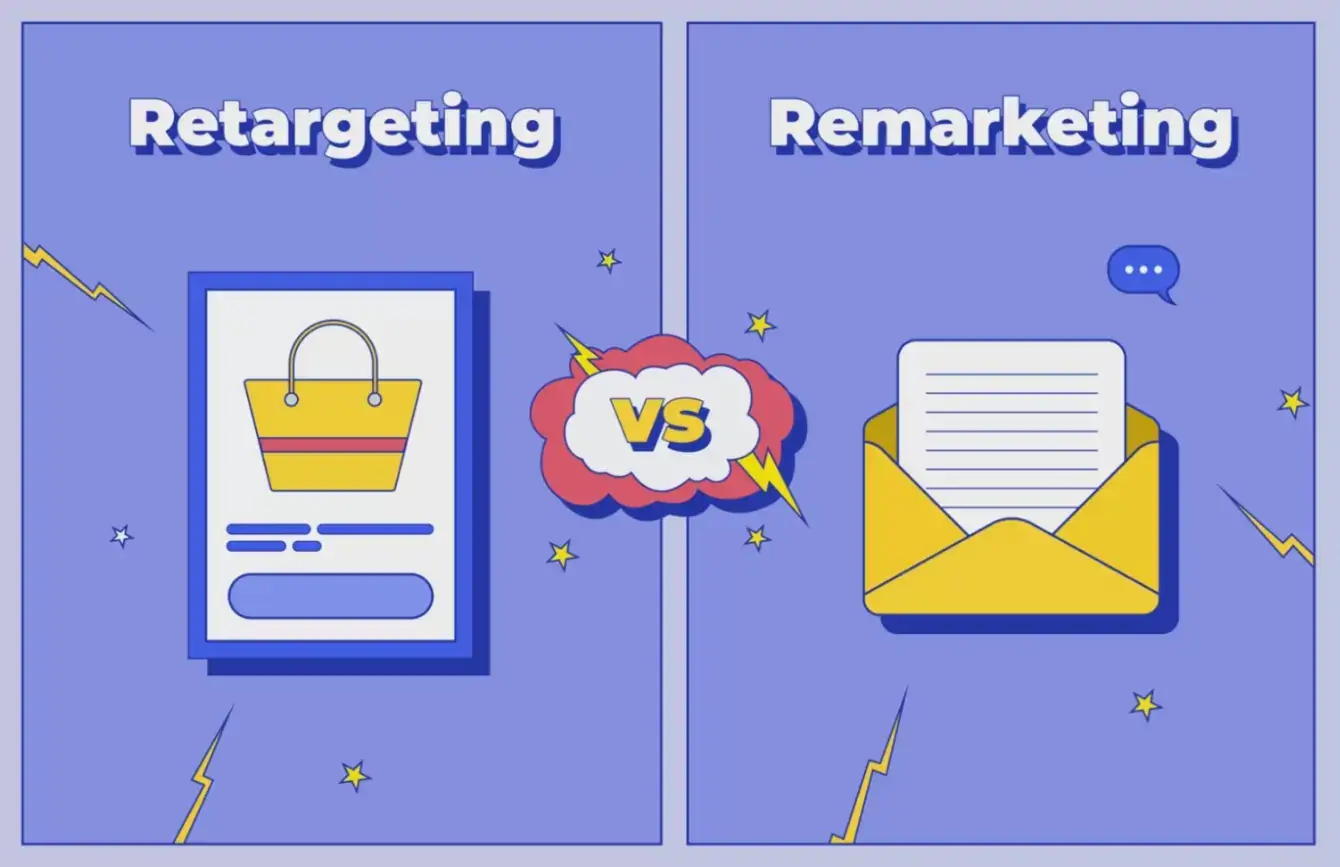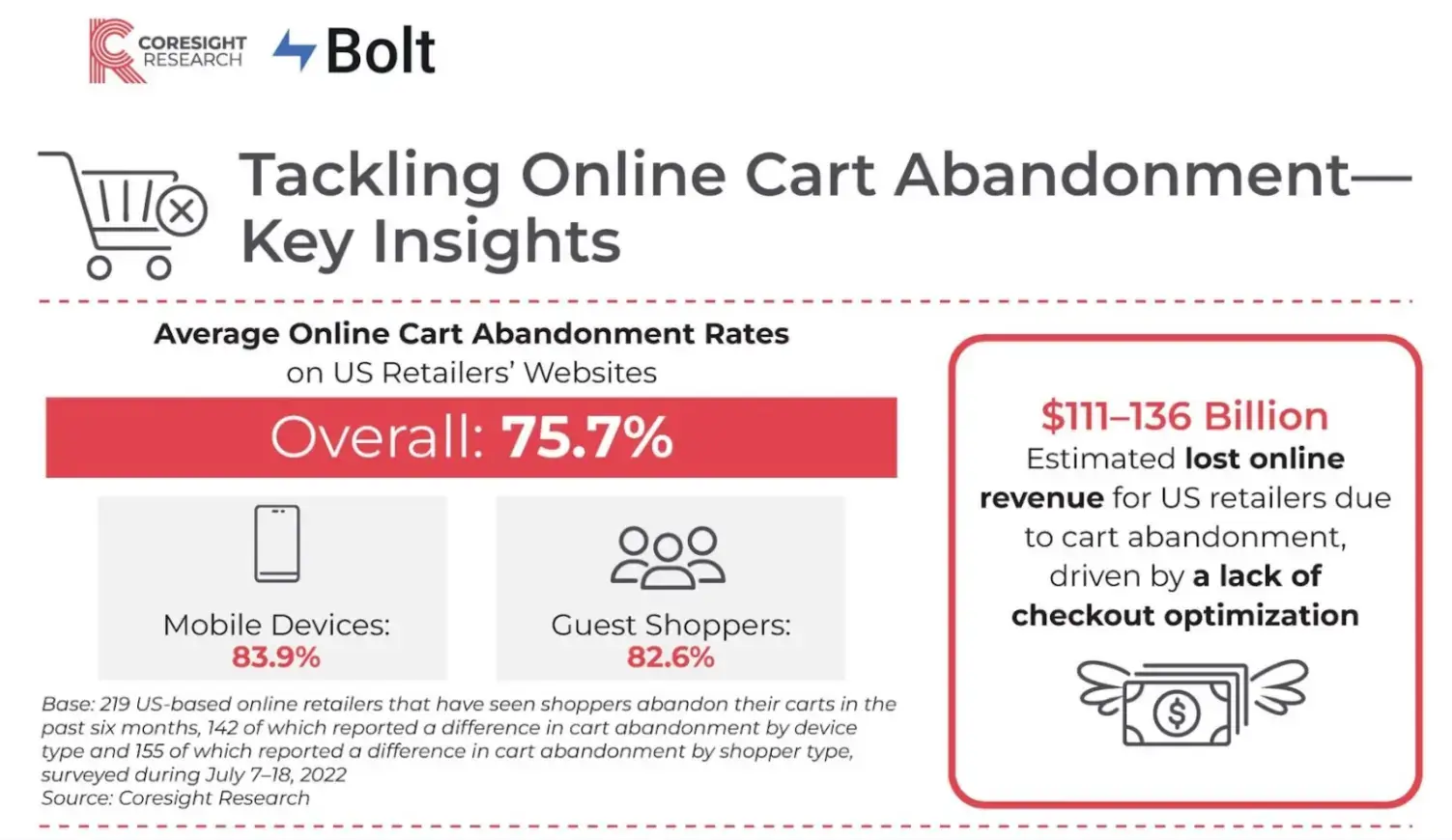Remarketing refers to engaging audiences who have already interacted with your brand, to encourage them to take desired actions that may interest them, such as a conversion. An example of remarketing is when a customer logs into your site, adds products to their shopping cart but leaves without making a purchase.
Using the email address provided by the customer, you can remarket by sending emails to remind them about the product. Hopefully, the email will help prevent cart abandonment.
Why should you consider a remarketing strategy? Well, the fact that a single remarketing campaign can lead to an increase in conversion rate by up to 161% could be reason enough.
Article Shortcuts:
Remarketing vs. Retargeting

Remarketing and retargeting share similar goals, to increase conversions from consumers most likely to buy from your brand. The two terms are often used interchangeably, however, there are key differences you should be aware of.
Retargeting commonly refers to online ad placement or display ads targeting users who have interacted with your site in a specific way but have not made a purchase.
A visit to your site sets a cookie in their browser, and you can use this information to retarget them with ads based on their interaction with your site. Third parties such as the Google Display Network usually place these ads. They are also regularly used by Facebook.
Remarketing is all about re-engaging existing customers through media platforms like email or paid ads.
Traditional remarketing examples include emailing a customer to renew a service or upsell an accessory. It can also take the form of a reminder, reminding a customer they have items in their shopping cart and encouraging them to complete their purchase.
Tips for Success in Remarketing and Retargeting

Remarketing and retargeting can help you turn almost any customer into a lead and increase brand awareness. They are also one of the best ways to reach people who have visited your site but left without making a purchase.
If you want to learn more about the various remarketing and retargeting strategies you can adopt, here are some top tips for success.
-
Segment and go for a larger audience
Your retargeting campaigns will be more successful if you segment them to target different audiences.
The most obvious place to start is segmenting your audience based on where and how they’ve interacted with your brand. If you’re running an eCommerce business, for example, you should create lists based on the web pages your visitors have visited and how far down the conversion path they went.
As Keran Smith, Co-Founder and CMO at LYFE Marketing, adds, “There are different types of segmentation you can use such as behavioral segmentation which involves sorting and grouping customers based on their actions and interactions. Segmenting by time is another option. Users who recently engaged with your site are more likely to take action again.”
-
Reach users across multiple platforms and use a variety of ad formats
Leveraging multiple remarketing strategies can expand the reach of your remarketing efforts.
Platforms you can use include social media, email marketing, and display advertising, and they can reinforce your brand message in many ways. At the same time, make sure you’re maintaining a consistent presence across multiple platforms.
When you reach out to customers using a variety of platforms, you increase brand awareness, build trust, and maximize your remarketing efforts.
-
Offer coupons and other incentive

Coupons, gift card programs, and similar incentives are another effective retargeting strategy. Offer them to visitors who keep returning to your site or who view certain pages.
Customers who keep returning are generally very interested in what you have to offer, so giving them a 10 percent off coupon or BOGO deal might be just what they need to convince them to take the final step and buy one of your products.
If you use remarketing, they’ll keep seeing your ad whenever they go online, but the difference is that for subsequent visits, there’s a discount they can take advantage of. Incentives can play a key role in your digital marketing strategy.
-
Focus on lead generation content
Lead generation content works very well as part of a remarketing strategy for several reasons.
Firstly, it keeps your brand front and center in the minds of potential customers who have already shown an interest in your products or services.
Secondly, by providing valuable content tailored to their needs, you can further nurture these leads, building trust and rapport, which are essential for driving conversion rates in the long term.
You can use AI here and create content that you can proofread, polish, and humanize to a fantastic level.
There is nothing wrong with that as long as the content is of high quality.
AI-powered remarketing is a powerful tool that can also help you find and target abandoned leads and significantly improve the efficiency of your remarketing strategy with data analysis and automation.
-
Tackling cart abandonment

One of the most effective ways to increase conversions is to use remarketing on your shopping cart and abandoned cart pages. When a customer has already shown interest in a product, they’re just one step away from making a purchase.
As soon as they leave the pages of your website, remarket them and continue to remind them to return to their abandoned carts and finish their purchase.
-
Create personalized landing pages
Landing pages can be crucial in a remarketing strategy for several reasons. They work effectively because:
- They are relevant and consistent: Creating personalized landing pages specifically for your remarketing ads ensures a consistent and relevant user experience.
- They increase conversion rates: Landing pages are designed with conversion in mind, following the web design principles of clear and actionable calls to action. They remove any unnecessary elements and guide visitors toward specific actions.
- They improve user engagement: Dedicated landing pages allow you to present information in a focused and streamlined manner. Visitors encounter exactly what they’re looking for without distractions.
- They allow you to track user behavior: You can monitor specific metrics such as bounce rates and time spent on a page and calculate conversion rates.
As Ivaylo Georgiev, SEO Manager at VPSBG, adds, “Landing Pages are also much more prone to being optimized on a technical level. Think about it, you are removing a vast majority of the clutter that is already on the page in terms of irrelevant text, images, and interactive elements in order to make your CTA and vital information stand out!
This will not only result in your page loading faster, but the overall UX benefit that you will get out of it is also incredible (not to mention the fact that search engines love optimized pages that load quickly on all types of devices)!
Also, given that landing pages are one of the few core factors that play an important role in determining your ads’ general performance, you are much better off creating a personalized page as that will not only help your remarketing efforts be noticed by more people from your list, but will also result in lower overall cost per click!”
-
Polish your call-to-action
Polishing your call-to-action (CTA) is crucial because it allows you to refine your message and offer based on your audience's behavior and interests.
By optimizing your CTA, you can create a more compelling and personalized call-to-action that resonates with your remarketed audience, increasing the chances of engagement and conversion.
In addition, a well-crafted call-to-action can prompt users to take immediate action by instilling a sense of urgency or incentive.
As the team at Engenius recommends: “Play around with different CTAs throughout your site. Consider middle-of-funnel calls-to-action like lead generators in exchange for emails, rather than always going for the sale.”
-
Tracking performance and A/B testing

Tracking performance and conducting A/B testing are essential components of a remarketing or retargeting strategy because they provide valuable insights into the effectiveness of your campaigns and help optimize them for better results.
Tracking performance metrics such as click-through rates, conversion rates, and return on investment allows you to identify which remarketing or retargeting tactics are performing well and which ones could be improved.
Using A/B testing, you can experiment with different ad types, messaging formats, and targeting strategies to determine what resonates best with your audience. Testing and optimization can help you refine your efforts over time and ultimately drive higher engagement and conversions.
Common Misconceptions About Remarketing
Some common misconceptions about remarketing include:
-
Stalker perception
One common misconception is that remarketing makes a brand appear too aggressive or “stalkery” to consumers. However, if it’s done correctly and with sensitivity in terms of frequency and messaging, potential customers will find the reminder helpful rather than annoying.
-
Limited audience
Another misconception is that remarketing only targets those who have previously visited a website. In reality, you can be far more nuanced and target users based on a variety of interactions, such as social media interactions or email engagement.
-
Ineffective for conversions
Some believe that if a user doesn’t convert the first time, they’re unlikely to convert in the future. However, the truth is that remarketing sales pitches often reach users at different stages of their journey and provide additional touchpoints that can ultimately lead to conversion.
-
High costs
While remarketing requires a budget, it’s not as expensive as many think. The precise targeting and potential for higher conversion rates can make it a cost-effective strategy, especially compared to broader advertising approaches.
-
Only for eCommerce

Admittedly, remarketing is commonly associated with eCommerce, but it can also be effective for various other industries and goals. These include lead generation, brand awareness, and app downloads.
Understanding these misconceptions can help you leverage remarketing more effectively by addressing concerns and implementing strategies that resonate with your audience.
Wrapping Up
In conclusion, implementing effective remarketing strategies can significantly enhance conversion rates and drive business growth. By leveraging tailored messaging, precise audience targeting, and strategic optimization, businesses can maximize the impact of their remarketing efforts.
Remember, success in remarketing lies in understanding your audience's behavior, continuously tracking performance, and iterating based on insights gained.
With the right approach, remarketing becomes a powerful tool for re-engaging potential customers and a cornerstone of a successful digital marketing strategy. So, take the insights in this guide, adapt them to your unique business objectives, and watch your conversion rates soar.
Author Bio
Veselin Mladenov is a digital marketing and SEO specialist with 3 years of experience as a content and affiliate manager for ThriveMyWay and more than 10 years in the field of corporate marketing and sales.



